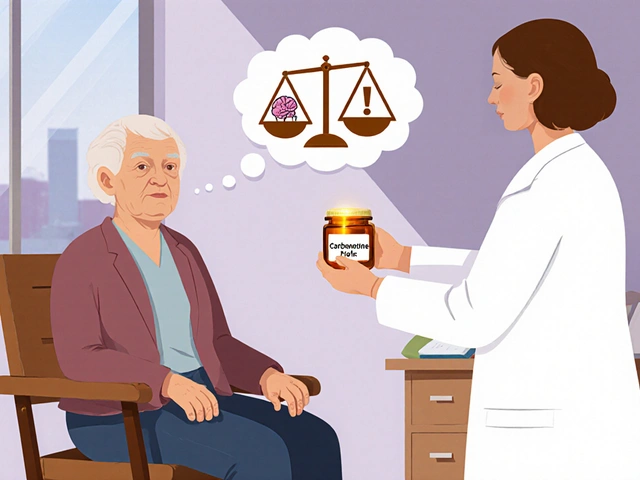Reglan sounds like the name of a sci-fi villain, but it’s actually a medication folks run into often—sometimes without realizing it. You’d be surprised how many people hear “Reglan” at the pharmacy and blink, only to nod when the word “metoclopramide” pops up. Reglan’s not some obscure prescription; it’s been around since the 1970s and has saved many a road trip by preventing relentless vomiting and nausea. It’s not just for carsick kids in the back seat, though. Adults dealing with severe heartburn, gastroparesis, or stubborn migraines get acquainted with this drug more than you might think. Yet, with all its perks, Reglan’s got a controversial streak that keeps doctors and patients on their toes. My Irish Setter, Rufus, has a stomach of steel, but I’ve seen a few people who can’t say the same.
What Exactly Is Reglan and Why Do Doctors Prescribe It?
Reglan, or metoclopramide if we’re being technical, is best known for speeding up how quickly food leaves your stomach. Picture your stomach after a massive meal. Sometimes, food just sits there, churning and refusing to budge. Reglan nudges the stomach muscles, telling them to move things along to the small intestine. Why does this matter? Well, if you’ve ever had that awful burning feeling behind your chest (that’s GERD talking) or felt painfully full hours after eating (that’s gastroparesis), you know how miserable it gets. Reglan’s FDA-approved for short-term use in adults dealing with severe, hard-to-treat cases of these problems.
For chemo patients, nausea and vomiting can ruin an already hard day. Reglan helps block the signals in your brain that trigger the urge to hurl, making it a go-to for both cancer patients and people with migraines who just can’t keep food down. There are off-label uses, too. Some doctors use it for morning sickness, or to help stimulate milk production for breastfeeding mothers. But here’s the thing: the FDA isn’t big on long-term use because Reglan has a record for causing certain neurological side effects. More on that later.
Now for one of the most underrated facts: Reglan doesn’t just work in your gut. It tweaks the way your brain talks to your stomach by blocking dopamine receptors. This is where both the wonders—and the worries—of Reglan begin. Blocking dopamine can calm nausea but can also open the door to some odd side effects most people never expect from a stomach med.
How Reglan Works in the Body: A Peek Under the Hood
Metoclopramide is one of those multitaskers that keeps digestive systems running when they want to stall out. It boosts muscle contractions in your upper gut, so food and liquids stop dragging their feet and move where they belong. Think of Reglan as a traffic cop for your digestive tract, waving everything along to avoid a pile-up. This makes a real difference if your stomach empties slower than normal, which happens all the time in people with diabetes (yep, that’s diabetic gastroparesis). For these folks, food sticking around means blood sugar spikes and crashes like a cheap rollercoaster. Reglan can smooth things out, at least for a short while.
Still, Reglan does more than hustle food along. It blocks dopamine in the chemoreceptor trigger zone—a spot in the brain that sounds like NASA tech but is really just your body’s nausea command center. By blocking dopamine here, Reglan tones down the signals telling you to vomit. It also boosts another chemical, acetylcholine, which motivates your digestive muscles. This combo is why the drug works so well but also why it has some wild side effects if you use it too long.
One thing you’ll notice about Reglan: it works fast. After swallowing a pill, most people feel relief in about 30-60 minutes. Injectable forms kick in even quicker, which is handy in the ER when someone is green around the gills from a migraine or a stomach bug. Most people take Reglan 30 minutes before meals and at bedtime, but dosing can change depending on the problem. The golden rule? Never take it longer than prescribed, usually no more than 12 weeks, unless your doctor’s got a solid reason to break the rules.
You might be thinking, “Why so strict about time limits?” The answer’s tied to a little something called tardive dyskinesia—a mouthful that means jerky, involuntary movements that can stick around even after you stop the drug. The risks climb the longer you’re on Reglan, which is why doctors keep close tabs and try to limit use. Plenty of folks tolerate the drug fine for a few weeks, but longer than that and the gamble just isn’t worth it.

Known Side Effects and Key Safety Warnings
Reglan comes with more fine print than a home loan. Most people start off just fine but can run into side effects, especially if they’re on higher doses or taking it for months instead of weeks. The most talked-about issue is tardive dyskinesia. It looks like repetitive grimacing, lip smacking, or the kind of tongue waving that even my cat Eloise would find odd. Once this movement disorder kicks in, it rarely goes away. That’s why Reglan sports a black box warning—the FDA’s biggest “heads up” label.
Other possible side effects include drowsiness, fatigue, restlessness, and, sometimes, real mood changes. Some people report anxiety or depression getting worse. This isn’t super common at normal doses for short periods, but it’s real enough that you should let your doctor know if you feel off. There are also episodes of muscle stiffness (like severe spasms), tremors, and—in rare cases—neuroleptic malignant syndrome, which is a medical emergency. Here’s a chart to make it clearer:
| Side Effect | How Often | Can Be Serious? |
|---|---|---|
| Tardive Dyskinesia | 1 in 500 (long-term use) | Often permanent |
| Drowsiness/Fatigue | Common (up to 1 in 4) | Usually mild |
| Restlessness | Up to 1 in 6 | Can be bothersome |
| Muscle Spasms/Stiffness | Rare (<1%) | Yes |
| Neuroleptic Malignant Syndrome | Very rare (<1 in 10,000) | Life-threatening |
No point sugarcoating it: Reglan can cause trouble if you’re not careful. If you already have Parkinson’s disease, epilepsy, or a history of depression, your doctor will probably look for other options first. Pregnant folks sometimes get Reglan when morning sickness is so severe they can’t eat or drink, but the whole team is usually involved (OB, pharmacist, sometimes even a neurologist) to weigh the risks versus benefits. This isn’t the drug you take because you “think” you have acid reflux but haven’t checked with a pro.
Mixing Reglan with other drugs? Double-check with a pharmacist. There are more than 500 known drug interactions—everything from antidepressants and antipsychotics to certain painkillers can mix poorly with metoclopramide. Drinking alcohol while on Reglan amplifies drowsiness and can mess with your coordination, so keep it out of your glass.
Practical Tips, Unique Uses, and What to Expect During Your Course
If your doc hands you a prescription for Reglan, a few tips will make the ride smoother. First, take it exactly as prescribed—usually before meals and, if you’re on four times a day, also at bedtime. Swallow tablets whole, and try to be consistent with timing. If you miss a dose and it’s close to your next one, skip it; don’t double up, because that bumps up the risk for side effects. Some people get the liquid, which works the same way but might be easier if swallowing’s an issue.
- Keep track of both good and bad reactions. A little fatigue or dry mouth isn’t usually a big deal, but twitches, weird facial movements, or sudden mood changes? Call your doctor.
- Don’t drive or use heavy machinery until you know how Reglan hits you. Some people feel woozy, especially at first.
- If you're using it for short bouts of severe reflux or gastroparesis, expect symptoms to start easing up within days. If not, don’t just tough it out—let your provider know.
- Ask your pharmacist about any new meds or supplements you start. Mixing Reglan with certain depression or allergy meds, or even over-the-counter cold medicine, can increase your risks for side effects.
- Avoid alcohol—otherwise minor side effects can feel much worse.
What about pets, you ask? Despite Eloise’s curiosity and Rufus’s tendency to eat anything that hits the floor, Reglan isn’t for animals unless your vet calls the shots (it’s sometimes used for chronically nauseous dogs and cats, but dosing is totally different).
Long-term benefits from Reglan have a steep tradeoff. Doctors save it for folks who have no other good choices. For shorter stints—like knocking out relentless vomiting from a migraine or jumpstarting a sluggish stomach after surgery—Reglan can be a game-changer. But anyone hoping to stick with it for months or years needs to go over risks with their health team. With so many newer meds out there for reflux, heartburn, and migraine nausea, Reglan isn’t as popular as it once was, but it still has a place on the shelf for those tough-to-treat cases. Just take it seriously, ask questions, and, if your stomach or reflexes rebel, remember you have plenty of safer options worth checking out.




Nick Bercel
August 6, 2025 AT 01:14Trupti B
August 6, 2025 AT 01:42lili riduan
August 6, 2025 AT 20:59Also, please don't self-prescribe based on Reddit. I've seen too many people try to use this for 'mild nausea' and end up in neurology clinics.
Tejas Manohar
August 8, 2025 AT 15:44harvey karlin
August 8, 2025 AT 16:33Leslie Ezelle
August 9, 2025 AT 20:42Vivian Chan
August 9, 2025 AT 23:17Mohd Haroon
August 11, 2025 AT 02:29andrew garcia
August 11, 2025 AT 11:42ANTHONY MOORE
August 11, 2025 AT 12:31Jason Kondrath
August 11, 2025 AT 23:09VEER Design
August 13, 2025 AT 20:54Jose Lamont
August 15, 2025 AT 04:30Kathleen Root-Bunten
August 15, 2025 AT 17:13Ruth Gopen
August 15, 2025 AT 19:54